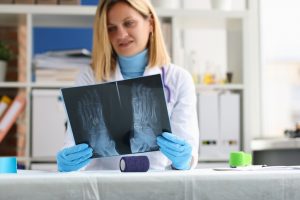 Bone spurs, also known as osteophytes, are small growths that often develop along the edges of bones in the joints or spine. They commonly occur in conjunction with certain arthritic conditions.
Bone spurs, also known as osteophytes, are small growths that often develop along the edges of bones in the joints or spine. They commonly occur in conjunction with certain arthritic conditions.
Bone spurs sometimes protrude from their position, causing you to feel bumps or knobs in the spots where they’re present and interfering with your range of motion in the affected area. In most cases, you may not experience any symptoms. However, if they do occur, they may include pain, numbness, weakness, or tears in tendons that rub against or come into contact with bone spurs.
The most common cause of bone spurs, osteoarthritis, is also the most common form of arthritis. It often affects adults aged 50 or older, though people of any age can suffer from osteoarthritis and, by extension, develop bone spurs.
Osteoarthritis isn’t the only form of arthritis that can cause bone spurs. Ankylosing spondylitis causes spinal inflammation and the fusion of your vertebrae, causing spinal bone spurs to form.
Bone spurs that aren’t causing painful symptoms likely won’t require treatment, but if they’re significantly interfering with your daily life, a doctor can prescribe medication and physical therapy or recommend surgery to remove them. Additionally, applying ice to the affected area, taking over-the-counter pain relievers, losing weight to reduce pressure on your bones and joints, and using equipment such as supportive shoes or inserts can all help you manage your symptoms.
The best way to prevent bone spurs is to prevent the conditions that cause them. This can be achieved by maintaining a healthy weight, exercising to maintain your range of motion, controlling your blood sugar, and making an effort to preserve your joints through stretching and the use of protective equipment.
You can schedule an appointment with a doctor at Flushing Hospital’s Ambulatory Care Center to receive a diagnosis or explore your treatment options by calling (718) 670-5486.
All content of this newsletter is intended for general information purposes only and is not intended or implied to be a substitute for professional medical advice, diagnosis or treatment. Please consult a medical professional before adopting any of the suggestions on this page. You must never disregard professional medical advice or delay seeking medical treatment based upon any content of this newsletter. PROMPTLY CONSULT YOUR PHYSICIAN OR CALL 911 IF YOU BELIEVE YOU HAVE A MEDICAL EMERGENCY.
